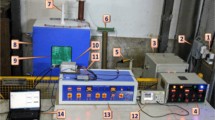Abstract
The organic nature of composite insulators makes them vulnerable under various stress even though they offer many advantages compared to ceramic counterparts. This premature aging will create a major change in surface profile, variation in chemical bonding and hydrophobicity. Those factors will make the polymers lose their insulation property, resulting in an increase in leakage current, causing frequent flashover. This can ultimately make insulators of this type fail at normal operating voltage, causing disruption in power utilities, resulting in huge economic losses. So in this regard an attempt has been made by the author in the work to understand the chemical phenomena behind this premature natural aging. The various categories of insulators with profiles termed as virgin, 2 years aged, 3 years aged with bio growth, shrinked and flashover has been collected from the marine environment. Analysis of the insulators by Fourier transform infrared spectroscopy indicates that as the insulators age there will be serious decrease in aging resistance, degradation resistance and hydrophobic property. Shore A hardness indicates the surface becomes very hard with aging causing decrease in surface resistance. Water contact angle measurements indicate that material tends to become more hydrophilic. The silica oxidation, oligomer formation and shielding effect reduction are the main factors leading to the insulation failures of field aged insulators. This work will help power system engineers timely replace aged insulators of the type and prevent huge economic losses to the utility industry.






Similar content being viewed by others

References
M. Amin, M. Salman, Aging of polymeric insulators (an overview). Rev. Adv. Mater. Sci. 13, 93 (2006)
N.C. Mavrikakis, P.N. Mikropoulos, K. Siderakis, Evaluation of field-ageing effects on insulating materials of composite suspension insulators. IEEE Trans. Dielectr. Electr. Insul. (2017). https://doi.org/10.1109/TDEI.2016.006077
H. Zhang, Y. Tu, Y. Lu, Z. Xu, C. Chen, L. Xie Study on aging characteristics of silicone rubber insulator sheds using FTIR, in IEEE International conference. https://doi.org/10.1109/ELINSL.2012.6251431
S. Nandi, B.S. Reddy, D. Sharma, Performance of composite insulators used for electric transmission under extreme climatic conditions. J. Mater. Eng. Perform. 28, 5959–5969 (2019). https://doi.org/10.1007/s11665-019-04341-3
S. Nandi, B.S. Reddy, Understanding field failures of composite insulators. Eng. Fail. Anal. (2020). https://doi.org/10.1016/j.engfailanal.2020.104758
Z.W. Gao, X.C. Zhu, S.J. Yang, H.Y. Nie, The FTIR analysis of field aged composite insulators. Adv. Mater. Res. 1008–1009, 620–623 (2014)
Z. Wang, X. Zhang, F. Wang, X. Lan, Y. Zhou, Effects of aging on the structural, mechanical, and thermal properties of the silicone rubber current transformer insulation bushing for a 500 kV substation. SpringerPlus. (2016). https://doi.org/10.1186/s40064-016-2549-y
A.E. Vlastos, S.M. Gubanski, Surface structural changes of naturally aged silicone and EPDM composite insulators. IEEE Trans. Power Deliv. (1991). https://doi.org/10.1109/61.131149
R. Sundararajan, A. Mohammed, N. Chaipanit, T. Karcher, Z. Liu, In-service aging and degradation of 345 kV EPDM transmission line insulators in a coastal environment. IEEE Trans. Dielectr. Electr. Insul. (2004). https://doi.org/10.1109/TDEI.2004.1285906
Y. Xiong, S. Rowland, J. Robertson, R. Day, Surface analysis of asymmetrically aged 400 kV silicone rubber composite insulators. IEEE Trans. Dielectr. Electr. Insul. (2008). https://doi.org/10.1109/TDEI.2008.4543114
M.F. Alhari, Life expectancy and future performance of SiR and EPDM nonceramic insulators through FTIR spectroscopy and analytical methods. Int. J. Manag. Appl. Sci. (2018). https://doi.org/10.1109/SusTech.2018.8671373
D. Ghosh, D. Khastgir, Degradation and stability of polymeric high-voltage insulators and prediction of their service life through environmental and accelerated aging processes. ACS Omega. (2018). https://doi.org/10.1021/acsomega.8b01560
Li. Cheng, S. Shao, S. Zhang, R. Liao, L. Yang, C. Guo, Research on the long-time operation performance of composite insulator shed hydrophobicity under hydrothermal conditions. IET J. Eng. Technol. 3(1), 67–72 (2018). https://doi.org/10.1049/hve.2017.0117
P.D. Blackmore, D. Birtwhistle, G.A. Cash, G.A. George, Condition assessment of EPDM composite insulators using FTIR spectroscopy. IEEE Trans. Dielectr. Electr. Insul. (1998). https://doi.org/10.1109/94.660819
Z. Liu, R. Sundarajan, A. Mohammed, J. Graves, SEM and FTIR Analysis field aged vs. laboratory aged polymeric surge arresters. Microsc. Microanal. (2004). https://doi.org/10.1017/S1431927604887749
X. Huasong, C. Xie, R. Wang, B. Gou, S. Luo, J. Zhou, Effects of electrical-hydrothermal aging degradation on dielectric and trap properties high temperature vulcanized silicone rubber materials. RSC Adv. (2020). https://doi.org/10.1039/D0RA00134A
ASTM D-2250. Standard Test Method for Rubber Property—Durometer Hardness (2017)
Mq. Bi, R. Deng, T. Jiang, X. Chen, A. Pan, L. Zhu, Study on corona aging characteristics of silicone rubber material under different environmental conditions. IEEE Trans. Dielectr. Electr. Insul. (2022). https://doi.org/10.1109/TDEI.2022.3163792
M.T. Nazir, B.T. Phung, Y. Shihu, S. Li, Resistance against AC corona discharge of micro-ATH/ nano-Al2O3 co-filled silicone rubber composites. IEEE Trans. Dielectr. Electr. Insul. 25(2), 157–167 (2018). https://doi.org/10.1109/TDEI.2018.006914
M. Amin, A.K.M. Ali, Accelerated aging investigation of silicone rubber/silica composites for coating of high-voltage insulators. Electr Eng J. (2018). https://doi.org/10.1007/s00202-016-0498-7
Acknowledgments
The author likes to acknowledge the Center for Material Testing laboratory of M.S.Ramaiaih Institute of Technology, Bangalore for using the facility.
Funding
None.
Author information
Authors and Affiliations
Corresponding author
Ethics declarations
Conflict of interest
None.
Additional information
Publisher's Note
Springer Nature remains neutral with regard to jurisdictional claims in published maps and institutional affiliations.
Rights and permissions
Springer Nature or its licensor (e.g. a society or other partner) holds exclusive rights to this article under a publishing agreement with the author(s) or other rightsholder(s); author self-archiving of the accepted manuscript version of this article is solely governed by the terms of such publishing agreement and applicable law.
About this article
Cite this article
Rao, V.V. Assessment of Insulation Failure of Field Aged 11 kV Polymeric Insulators of Marine Environment with Characterizations Technique. J Fail. Anal. and Preven. 23, 1932–1939 (2023). https://doi.org/10.1007/s11668-023-01730-8
Received:
Revised:
Accepted:
Published:
Issue Date:
DOI: https://doi.org/10.1007/s11668-023-01730-8



